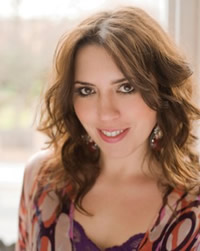The UNCG Contemporary Chamber Music programs are always well prepared and can be counted upon to be challenging and diverse. They may even be entertaining. Such was the case at their November 20 concert in the splendid Recital Hall of the University of North Carolina at Greensboro’s School of Music. A mixture of small ensembles as well as larger chamber groups under the direction of Robert Gutter took the stage.
The memory of Olga Kern’s performance of Robert Schumann’s Kinderszenen helped the appreciation of Sebastian Currier’s “Verge” (1997). The composer (b.1959) was intrigued by the title of one movement of the Schumann piece, “Almost too serious.” He writes that “the idea of being on the verge of extremity but not crossing it is appealing to me and I thought to write a piece that elaborated on the precious sense of balance.” Eight short movements explore “almost too fast, almost too slow, almost too mechanical.,” etc. Violinist Dan Skidmore, clarinetist Luc Jackman and pianist James Smith skirted this edge with wit and skill, exploring a wide range of color and technique. It is a trenchant piece for small ensemble that deserves wide circulation.
Composer J. Mark Scearce (b.1960) is very familiar to Triangle audiences because of his association with both the N.C. Symphony as well as his stint as composer-in-residence at NCSU for two years. His long resume (Yaddo, 1998, the MacDowell Colony, 1993, etc.) is most impressive. His “The Night That I Had Dinner With José Greco” (1996) is a postmodern flamenco dance for violin and marimba (and was) inspired by a very real meal with .the dancer(Program Notes).” Played by violinist Colleen Chenail and marimbist A.J. Chenail, the violin hinted at a Spanish flavor as the piece built up intensity. While its highest register was exploited, the marimba basked in rich low notes.
As a long lover of the Spoon River Anthology, I relished the inspiration and treatment of materials in Eddie Bass’s “Epitaphs (1985, revised 2002). The composer (b.1938), a N.C. native and a graduate of UNC-Chapel Hill (Ph.D., 1964), is now Professor of Music and Coordinator of Composition at UNCG. His piece, for mezzo-soprano, flute, cello, percussion and piano, is a setting of six inscriptions from New England cemeteries. None are famous, the composer “chose the texts because (he) liked their imagery, rhythms, or drama (Program Notes).” Gutter directed the performance. Levone Tobin-Scott was the excellent soloist with a well-supported and projected voice and crystal clear diction essential in putting across the wide-ranging narratives. That for Jane Graham (d.1863) was an imagined sentimental dialogue between a young wife and her surviving husband. The composer used material from Stephen Foster’s “Ah! May the Red Rose Live Away” and quotes it directly near the end. Dramatic and agitated, Warren Gibbs (d.1812) headstone declares that his wife poisoned his oysters. This would be an ideal piece for the Mallarmé Chamber Players.
Composer Aaron Kernis (b.1960) had the too small audience in stitches with the over the top humor of his “Le Quattro Stagioni Dalla Cucina Futurismo” (“The Four Seasons of Futurist Cuisine”) (1992), for Narrator, Violin, Cello and Piano. One of the youngest composers to ever be awarded the Pulitzer Prize, he worked the text of the manifesto of 1930s Italian Futurist Filippo Tommaso Marinetti (who advocated fast, high tech food) into an extended monologue with accompanying music or sounds. The shades of Da-Da-ism and Satie must have haunted its composition. The only shortcoming of the excellent program notes was the omission of the outlandishly funny text. This requires an actor able to do Noel Coward texts and narrator Robert Wells was peerless. Though miked, he was briefly covered in the first third of the performance. The writing for violin, cello and piano ranged from romantic, through dissonant and even had the musicians vocalizing all sorts of noises and calls. The able players were Janet Orenstein, Brooks Whitehouse and Brian Marble, respectively. Kudos for their keeping nearly straight faces and keeping to the score faithfully. The work deserves wide exposure.
Currently assistant professor of music at Indiana University Southeast, composer Kurt Sander (b.1969) drew upon “six years of personal research into a compositional methodology fusing music with the sacred and symbolic art of the Byzantine East.” Scored for flute, clarinet and bass clarinet, bassoon, two violins, viola, cello, doublebass, extensive percussion and piano, Sander uses a rich language that utilizes Russian Orthodox Church chant harmonies to represent the Transfiguration. Gutter directed this moving work that has a slow but soothing pulse and a sense of timelessness. Cellist Meaghan Skogen merited an extra curtain call for her concertante part, in effect leading the wordless chant, playing in almost every bar of the score. The other strings either served as a base or responded almost as a chorus. Multiple sets of tubular bells added to the feeling of a church ritual.
A CD of this concert would make an ideal promotion of both the high quality of compositions selected and of the high standards of their performance experienced in the UNC-Greensboro Contemporary Chamber Players series. Too bad the audience was barely three dozen.











